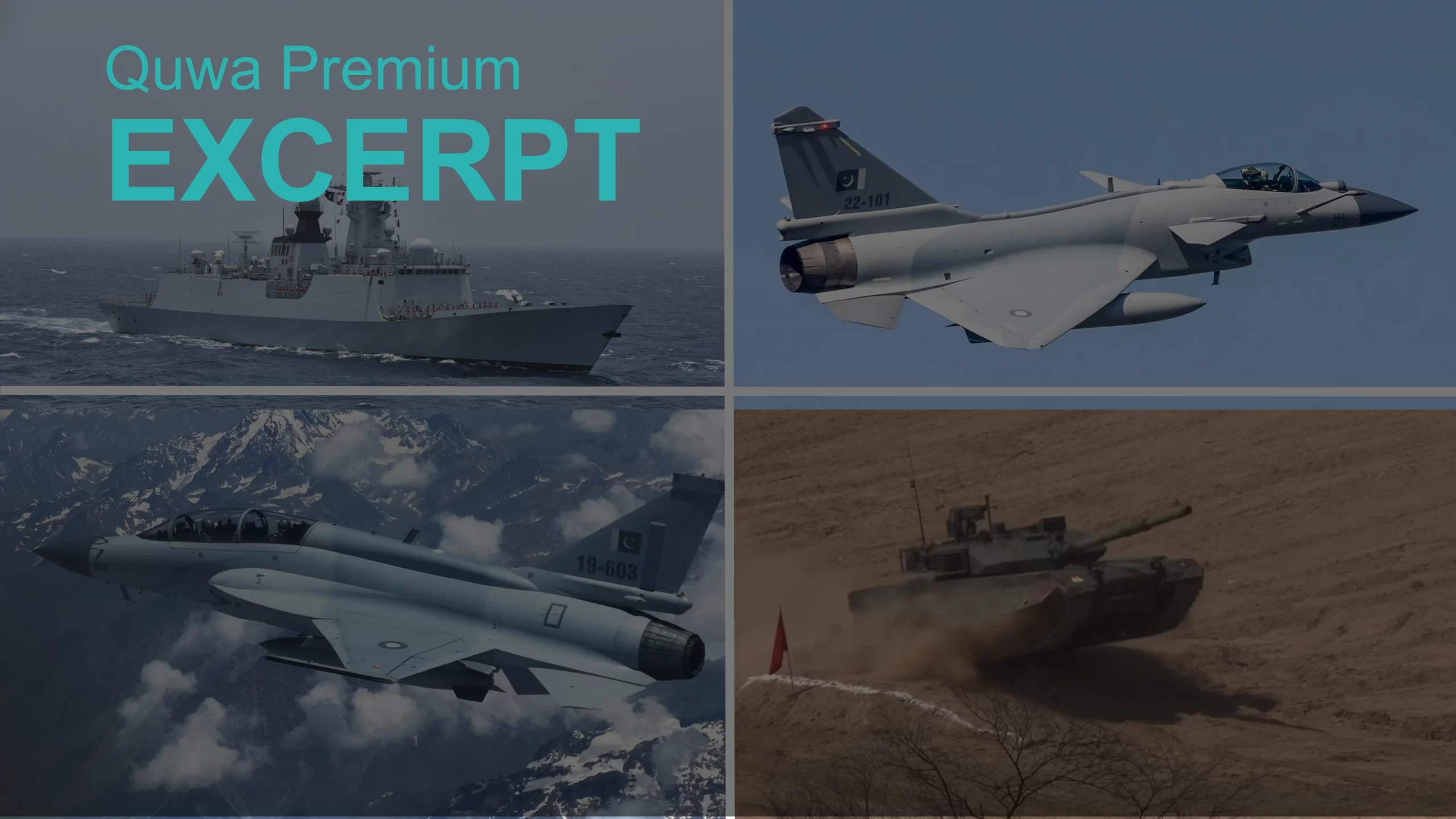3028Views 29Comments

Pakistan Air Force Chief sets expectations for near and long-term force goals
In an interview with Pakistan’s state-owned national television network, PTV, the Pakistan Air Force (PAF) Chief of Air Staff (CAS) Air Chief Marshal (ACM) Sohail Aman outlined the PAF’s near and long-term force modernization objectives. (Note: the interview is in Urdu)
Currently, the PAF is phasing out 190 legacy Chengdu F-7P and Dassault Mirage III/5 combat aircraft from its fleet (more than 50 have already been retired). With the aim to supplant these fighters by 2020, ACM Sohail Aman stated that the JF-17 Thunder, which is co-produced by Pakistan Aeronautical Complex (PAC) and Chengdu Aerospace Corporation (CAC), is at the center of these procurement efforts. ACM Aman added that the forthcoming JF-17 Block-III, the Thunder’s first majorly upgraded variant, is projected to enter production in 2019-2020.
With the PAF “very satisfied” with the JF-17, ACM Aman indicated that the Thunder will receive most of the PAF’s investment. Bringing the JF-17 to complete maturity (via the Block-III) is a priority. However, ACM Aman added that the PAF is still engaged with the U.S. about procuring additional F-16s.
The proposed purchase of eight new-built F-16C/D Block-52+ in 2016 fell through as a consequence of the U.S. Congress’ refusal to release Foreign Military Financing support to partly subsidize the deal. However, the PAF is in talks with the U.S. for those (eight) and additional aircraft.
ACM Aman mentioned efforts towards procuring a new off-the-shelf fighter. He stated that the PAF is in talks with several countries in regards to 5th-generation fighter aircraft. These talks are in the advanced stages and will be sought to “plug in” gaps. Interestingly, ACM Aman mentioned this project separately from indigenous efforts, which he said will require PAC to develop a next-generation fighter as well as its internal subsystems, such as its avionics.
The domestic development and manufacturing of a next-generation fighter is a long-term goal. Next month, Kamra Aviation City will enrol its first cohort of post-graduate engineering students, who will study disciplines directly relevant to aircraft manufacturing. Kamra Aviation City’s institutes will closely work with the aviation industry. ACM Aman emphasized the need for the PAF – and the country as a whole – to become as independent as possible in sourcing technology.
ACM Aman also confirmed that the two heavily damaged Saab 2000-based Erieye airborne early warning and control (AEW&C) aircraft were domestically repaired. He stated that the price quoted by the original equipment manufacturer (OEM) was U.S. $287 million, but the work was domestically undertaken for a much lower cost – $25 million.
Notes & Comments:
It appears that F-16s are still on the PAF’s roadmap. This is not surprising considering the infrastructure to operate these aircraft, especially the Block-15 and Block-52+, are already in place. For the PAF, these aircraft would provide the lowest acquisition and operational costs in comparison to other Western multi-role fighters. However, the focus appears to be on bringing the JF-17 Block-III to fruition and having the Thunder continue its trajectory in forming the mainstay of the PAF fighter fleet in the near-term.
ACM Aman’s comments about procuring a 5th-generation off-the-shelf fighter are unclear. On the surface, this interview alludes that there are two 5th-generation fighter initiatives; a near-term project to procure an aircraft off-the-shelf, and a long-term program to develop and manufacture a fighter at PAC. In 2016, ACM Aman clearly stated that the PAF would develop a next-generation fighter, one that could encompass attributes not found on existing 5th-generation fighters. On the other hand, the two need not be mutually exclusive; a near-term procurement could evolve into domestic manufacturing under license.
Besides the Chengdu J-20, the remainder of plausible off-the-shelf next-generation fighters are in various stages of development. The Shenyang FC-31 has reached its second prototype stage, while the Turkish TFX and Korean KFX are in the preliminary design stages. One of these could be sought for procurement in the mid-to-late 2020s, by which time many of the PAF’s F-16A/B Block-15 MLUs will touch the end of their 8,000 hour lifespans.



29 Comments
by Catalyst
FC-31 is going to be PAF’s short term solution, considering the PLA-N chooses J-31 for its upcoming aircraft carriers. PLAAF has no desire for J-31, at least publicly. TFX might be the joint product of Pak-Turkey collaboration, with each tailoring the “stock” TFX for its own requirements.
by Bilal Khan
There’s a wild card in Chengdu. While they won with the J-20, I can’t see them standing by to let Shenyang have the flexibility of pitching the FC-31 domestically and abroad without competition. The PAF has a relationship with Chengdu too.
by Catalyst
But China has been quite clear that J-20 is exclusively for China. Can we expect a change in that policy or something completely new from Chengdu?
by Bilal Khan
Seeing how Shenyang is labouring with trying to get PLAAF and PLAN orders for the FC-31, I think Chengdu has the incentive to offer a medium weight fighter for both domestic needs and exports. They’ll have to convince Beijing (for funding and approval), but seeing how celebrated Chengdu is for the J-10, J-20 and JF-17 (in Pakistan), it could happen.
by Omer Farooq
Why pakistan is not going to purchase su 35 for medium term or T50 for long term
Because Russia is not completely willing now to sell their 5th generation fighter to India.
But they showing interest to sell jets to Pakistan
Any body reply?
by Bilal Khan
There could be many reasons: (1) Russia is not willing to approve fighter sales to Pakistan, (2) Pakistan doesn’t want to pay upfront in cash (or can’t to the extent Russia might want), (3) too many uncertainties regarding supply, financing, customization, etc.
by Omer Farooq
Brother one thing that confuses me a lot. India is trying to buy latest F16, Rafael( with meotor missile ), JAS Gripen, and they are upgrading su 30. Why we are only relying on JF 17.
India is trying to make IAF so Strong.
And russian shows willingness to sale su 35.
We are only waiting for fc 31.
by Black Stone
Pakistan, at least, should participate in the TFX program though as an low tier participant if not a fully. Which will allow Pakistan to have an access to the design. Just like Israel is part of F-35 program. It will also help in JF-17 program in future upgrades.
by Omer Farooq
Strongly Agree
by Muhammad Khurram Bhatti
Not sure why you keep on insisting that next gen fighter program is for a 5th gen. fighter? ACM clearly stated an year ago that it will “replace” the 5th gen fighters. The two 5th gen he referred to could be J-20 and J-31.
by Bilal Khan
In 2016 he stated that the next-gen fighter should encompass capabilities not yet found on existing 5th-gen fighters. But this doesn’t preclude it from being 5th-gen, especially since the Aman said PAC’s future rests in manufacturing 5th-gen fighters. For the off-the-shelf part, he didn’t refer to two 5th gen fighters, but two-three countries for 5th-gen fighters.
by Aloo Piyaz
Pakistan needs to replace its 48 F-16 air crafts and for sure Pakistan can pay for at least 10 F-16’s but what I can understand is that Pakistan does not want to pay. Anyway, our JF-17 is still our backbone and the block 3 can become our front line fighter but for the long term we should get FC-31 as the Lockheed Martin might end the production of F-16.
by Waseem Sarwar
Well India have money to burn, we don’t. That the sad reality. Indian economy can bear such expensive acquisitions while Pakistan have to play within budget. Our best bet is to focus on chinese fighters which are quite decent except engines.
by Hahaha
Enough with the airforce, we got to focus on our navy… More subs are needed, perhaps nuclear powered, equipped with babar nuclear cruise capability.
by Muhammad Khurram Bhatti
If memory serves me good then he said something to the effect that the next gen aircraft will replace the 5th gen fighters and he specifically mentioned F-35 and J-31. From this I conclude that the next gen fighter will be a 5+ generation machine. You are correct about the existing 5th gen. prospects. He did say multiple countries.
by Zain YG
See the financial difference between pakistan and India.
Also, remember, when western companies wish, they can mess up the chain of supply to western armament to other nations, so India is gambling a bit with this.
by Zill e Hussnain
first thing first, India needs 42-45 squadrons but it only has 35 at the moment, among those 35 squadrons, Mig 29 and Su-30 are facing extreme operational issues as Su-30s are only around 55-60% operational and Mig 29 are around 45-55% operational. Thirdly Indian Air force will have to phase out all the 3rd generation air crafts including Mig 21 and Mig 27 in next 5-7 years which will take away 14 more squadrons so their strength will come down to 21,(Pakistan air force’s current squadron strength is 23), they may though keep the Jaguars for the ground attack role, the Tejas are not going to be operational any time soon to replace Migs and their performance is also highly questionable, their deployment in the battle field seems impossible, Indian air force does not have much in the pipeline to cover the gap, any thing realistic is only 36 Rafale and some up gradations in Su-30s, India is yet to make a decision between Gripen and F-16s under make in India, on the other hand, we already have around 86 JF-17 thunders which will replace F-7s and non ROSE Mirages, F-7PGs and Mirage ROSE will also be replaced by Block 3 and new F-16s/J10s or any 4.5Gen fighter so till 2025, Pakistan will successfully be able to phase out all the third generation air crafts and will be ready to induct a 5th generation air craft
by Bilal Khan
You can check the interview, it’s linked in the article.
by SP
Capability enhancements of JF-17, and it being the mainstay of the airforce for the next 2 or 3 decades makes logical sense, but the continued fascination of PAF leadership with F-16 is quite shocking in particular considering the humiliation faced by Pakistan at the hands of the US time and again. No self respecting nation would buy American 1970’s technology after that.
by Ezaz
We should approach Ukraine for cooperation in eastern European defense equipments ,
last year china & Ukraine sealed a deal for re-production of An-225 biggest plane ever.
So why not us ?
by John Rue
My guess is that PAF will look for surplus F-16s from other countries. Despite of all the promising stuff , Chinese stuff is still no where close to proven American and EU or even Russian technologies. It will be interesting to see if Trump administration will approve the purchase from a 3rd country.
by Omer Farooq
Plz give honest reply
Can our Jf 17 and BVR ( r darter and PL 10)
Compete Rafael and state of the art BVR(meotor) missile. if Jf 17 is only our medium term plan.
by Suhail Farooqui
Yes,this is big mystery,why are we so desperate to purchase 70s technology with those humiliations and other strings attached,more over thing called”switch or device”which is “apparently”installed in the jets to limit the ability to strike at far distance, sold to countries which are at war/disputes with neighboring countries,can any one plz shed some light on this issue,how far it is true ?????
by Kashif
“Next month, Kamra Aviation City will enrol its first cohort of post-graduate engineering students, who will study disciplines directly relevant to aircraft manufacturing” Though pretty late but right step on the path of self reliance.
by amar
@zill_e_hussnain:disqus
Hi dear!
Your figures are a bit outdated-
The operational availability issue of Su-30MKI has been increased above 65% as we speak and it is going to increase tremendously as and when Russia and India signs supply chain pact for the indian fleet of MKIs.
As for the MIg-29K,the operational availability was indeed found to be 55% but the same pact will enable in-house manufacturing of lot of consumables thereby increasing the operational availability.
As for the phasing out,only 21s and 23/27s will go out in next 5 years,rest everything else will remain as it is–however thoroughly upgraded.In fact to your surprise,Jaguars have already been upgraded with AESA radars and the tests are going on as we speak!
As for the tejas though,we must be a little more realistic and not go by petty nationalistic jingoism. Tejas has improved a lot in past 10 years–from enhancing the flight envelope,upgrading digital FBW to firing BVR missiles. What you fail to understand is the fact that IAF wants BVR,aerial refueling etc as a pre-requisite for FOC whereas no such thing was made mandatory when JF-17 entered service with PAF–basically PAF inducted the JF-17 when it couldnt even fire BVRs and then later incorporated all the tech over in subsequent baches.However IAF doesnt do that.
What is “certain” or imminent in next 5-7 years–by Imminent I mean funds and govt approval has been given:
For India:
1)Induction of 36 rafales
2)Induction of 123 LCA tejas and Tejas MK1(with AESA,EW suite and OBOGS)–this will make Tejas MK1 as capable as thunder blk3 if not any more!
3) Up gradation of jaguar,MKI with AESA radars and other advanced avionics. In fact entire IAF fleet of Mirage,jaguar,MKI,Mig-29 will be/have been “vastly” upgraded.Infact jaguar has already been upgraded with ELTA-2052 and the trials are going on.
4)Induction of indigenous 360 degree larger awacs based on A330
5)Phasing out of 21/23
For Pakistan:
1)Induction of JF-17 in other baches particularly Blk3.It remains to be seen what AESA they are gonna select.
2)Since no govt deal has been signed for either J-31 or F-16 blk52 I wont take that into account.
3)Upgrade of PAF F-16 and mirages
by Shakeel
Yes your right Bilal. Pak Russian relations are overblown by both countries to cement their existing interests.
by Chen
The Shenyang FC-31 seems better than Rafale in every aspect. It would be easy for Pakistan to upgrade its avionics with Turkish firms at later stage.
by Manju
9 squadrons of IAF posses MiG21 and MiG27. Current strength is 33 squadrons. Some Ex-IAF chief gave a magic number of 42 squadrons to stand in a 2 front war situation. Now even after 10 years if India achieves 42 squadrons some other guys will say India will need 52 squadrons to overcome an entire South Asian attack then the game of squadrons will start again. I feel the IAF squadrons coming down to 33 has been vastly exaggerated.In this day and age technology matters not the numbers.
by John Rue
its a little off topic but please also take India’s SAM purchases into the account. Would S-400 not be able to balance off any advantage PAF may have got? Considering how many aircrafts India has got, dont you think even 50% operational rate during a conflict will be good enough to counter Pakistan? What about missiles like Brahmos , IAF doesn’t even need to enter Pakistan airspace to fire them.